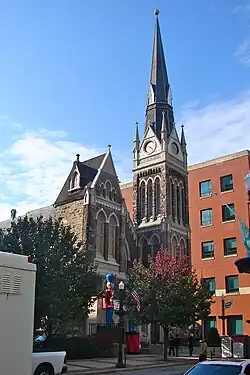High German Evangelical Reformed Church | |
 Zion United Church of Christ in October 2011 | |
 Location of the church in Pennsylvania  High German Evangelical Reformed Church (the United States) | |
| Location | 622 West Hamilton Street, Allentown, Pennsylvania, U.S. |
|---|---|
| Area | 0.5 acres (0.20 ha) |
| Built | 1762 |
| Architect | Lewis Jacoby |
| Architectural style | Late Gothic Revival |
| NRHP reference No. | 83002259[1] |
| Added to NRHP | July 28, 1983 |
The High German Evangelical Reformed Church, also known as Zion Reformed and Zion United Church of Christ, is an historic Evangelical and Reformed church, located at 622 West Hamilton Street in Allentown, Pennsylvania in the Lehigh Valley region of eastern Pennsylvania.
During the American Revolutionary War, the church was selected as the site to hide and protect the Liberty Bell from seizure as British troops prepared the Philadelphia campaign, designed to attack and occupy the revolutionary capital in Philadelphia. The Liberty Bell was hidden beneath floor boards in the church for nine months, from September 1777 until the British ultimately departed Philadelphia in June 1778.
Until 2023, the church houseed the Liberty Bell Museum, established to honor the role that Allentown and Lehigh Valley-area American patriots played in successfully guarding America's national symbol of freedom.
History
18th century

Initially built as a log structure on its present-day site at 622 Hamilton Street in Center City Allentown in 1762, the original High German Evangelical Reformed Church building was replaced in 1773 with a simple brick structure, which was designed in a vernacular federal style and erected a few yards north of the first log church's location.
Liberty Bell's hiding
In September 1777, as American patriots prepared for a British Army attack on the colonial-era capital of Philadelphia, the Liberty Bell and other bells in Philadelphia were ordered taken down and then hastily transported to present-day Allentown, which was then called Northampton Towne, where they were successfully hidden under the church's floor boards until June 1778 when the British abandoned Philadelphia.[2]
19th century
In 1838, when Zion Reformed was enlarged, contractors may have incorporated the 1762 structure into the walls of the current building's boiler room. The building was then enlarged further between 1886 and 1888 via gothic revival-style improvements made by architect Lewis Jacoby.[3]
20th century
In 1983, in recognition of the church's valuable contribution to the nation's early history, it was added to the National Register of Historic Places.[1]
Liberty Bell Museum
The Liberty Bell Museum, which commemorates the Liberty Bell's hiding in 1777, is located in the church's basement and is open to visitors.
See also
References
- 1 2 "National Register Information System". National Register of Historic Places. National Park Service. March 13, 2009.
- ↑ Bloom, Ken; Wolbers, Marian (1984). Allentown A Pictorial History (Special ed.). Norfolk, VA: The Donning Company/Publishers. pp. 18–19.
- ↑ "National Historic Landmarks & National Register of Historic Places in Pennsylvania". CRGIS: Cultural Resources Geographic Information System. Archived from the original (Searchable database) on 2007-07-21. Retrieved 2012-03-05. Note: This includes Theodore J. Mabus (June 1982). "National Register of Historic Places Inventory Nomination Form: The High German Evangelical Reformed Church" (PDF). Retrieved 2012-03-04.

